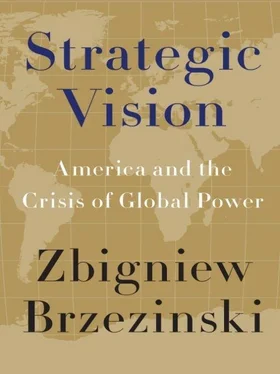Zbigniew Brzezinski - Strategic Vision - America and the Crisis of Global Power
Здесь есть возможность читать онлайн «Zbigniew Brzezinski - Strategic Vision - America and the Crisis of Global Power» весь текст электронной книги совершенно бесплатно (целиком полную версию без сокращений). В некоторых случаях можно слушать аудио, скачать через торрент в формате fb2 и присутствует краткое содержание. Город: New York, Год выпуска: 2012, ISBN: 2012, Издательство: Basic Books, Жанр: Публицистика, на английском языке. Описание произведения, (предисловие) а так же отзывы посетителей доступны на портале библиотеки ЛибКат.
- Название:Strategic Vision: America and the Crisis of Global Power
- Автор:
- Издательство:Basic Books
- Жанр:
- Год:2012
- Город:New York
- ISBN:9780465029556
- Рейтинг книги:4 / 5. Голосов: 1
-
Избранное:Добавить в избранное
- Отзывы:
-
Ваша оценка:
- 80
- 1
- 2
- 3
- 4
- 5
Strategic Vision: America and the Crisis of Global Power: краткое содержание, описание и аннотация
Предлагаем к чтению аннотацию, описание, краткое содержание или предисловие (зависит от того, что написал сам автор книги «Strategic Vision: America and the Crisis of Global Power»). Если вы не нашли необходимую информацию о книге — напишите в комментариях, мы постараемся отыскать её.
Strategic Vision: America and the Crisis of Global Power — читать онлайн бесплатно полную книгу (весь текст) целиком
Ниже представлен текст книги, разбитый по страницам. Система сохранения места последней прочитанной страницы, позволяет с удобством читать онлайн бесплатно книгу «Strategic Vision: America and the Crisis of Global Power», без необходимости каждый раз заново искать на чём Вы остановились. Поставьте закладку, и сможете в любой момент перейти на страницу, на которой закончили чтение.
Интервал:
Закладка:
In China, just as in India, British imperialism followed in the wake of British traders. The latter had run up huge monetary deficits by purchasing Chinese tea, porcelain, silk, and so on, for which they sought remedy by selling opium to Chinese importers. Beijing’s belated efforts to ban the import of opium and restrict the access of foreign merchants then precipitated two armed interventions, first by the British and then by both the British and the French, which further contributed to a precipitous decline in China’s role in the global economy.
The historic fact of China’s and India’s past economic preeminence has led some to argue that the current economic rise of Asia is basically a return to a distant but prolonged normality. But it is important to note that Asia’s earlier superiority in GNP was attained in a world of basically isolated regions and thus of very limited economic interactions. The economic links between Europe and Asia involved trade based largely on barter, transacted primarily in just a few ports (notably Calcutta) or transported by periodic caravans slowly traversing the Silk Route. A global economy, continuously interactive and increasingly interdependent, did not then exist.
Thus, in times past, Asia’s statistically impressive but isolated economic prowess was not projected outward. In the early part of the fifteenth century, China chose a policy of vigorously enforced self-isolation, having even earlier refrained from exploiting the technological superiority of its commercial fleet and oceanic navy to assert a political outreach. India under the Mughal Empire possessed great wealth, but it lacked political cohesion or external ambitions. Indeed, the only significant case of assertive westward projection of Asian political power occurred under the leadership of Mongolia’s Genghis Khan, whose horseback-riding warriors carved out a vast Eurasian empire. However, they galloped from a country with a miniscule GNP of its own—thus demonstrating that at the time military prowess was not handicapped by economic weakness.
2: THE RISE OF ASIA AND THE DISPERSAL OF GLOBAL POWER
The rise to global preeminence of three Asian powers—Japan, China, and India—has not only altered dramatically the global ranking of power but also highlighted the dispersal of geopolitical power. The emergence of these Asian states as significant political-economic players is a specifically post–World War II phenomenon because none of them could exploit their population advantage until the second half of the twentieth century. Admittedly, inklings of Asia’s emergence on the international scene first came into view with the brief rise of Japan as a major military power following its victory in the Russo-Japanese War of 1905. That unexpected triumph, however, was followed not long after by Japan’s embrace of militaristic imperialism that ended in total defeat at the hands of the United States in 1945 in a war that the Japanese had proclaimed was aimed to free Asia from Western domination. The subsequent national recovery of Japan from its massive destruction in World War II provided the first major preview of an Asia whose economic growth signaled growing international stature.
The combination of a stable pacifist democracy, a national acceptance of American military protection, and a popular determination to rebuild the country’s devastated economy created a fertile climate for Japan’s rapid economic growth. Based on high rates of savings, moderate wages, deliberate concentration on high technology, and the inflow of foreign capital through energetically promoted exports, Japan’s GDP grew from $500 billion in 1975 to $5.2 trillion in 1995. [2] World Bank: World Development Indicators, April 26, 2011.
Before long, Japan’s economic success was emulated—though in politically more authoritarian settings—by China, South Korea, Taiwan, the Association of Southeastern Asian Nations (ASEAN) countries, and Indonesia, as well as by the more democratic India.
The relatively complacent American public of the mid-twentieth century at first paid little attention to Japan’s new role in the world economy. But during the 1980s and early 1990s, American public anxiety suddenly focused on Japan. Public opinion was stimulated not by Japan’s geopolitical assertiveness—for it possessed a pacifist constitution and was a steadfast American ally—but rather by Japanese electronic and then automobile products’ highly visible domination of the American domestic market. US paranoia was fanned further by alarmist mass media reports of Japanese buyouts of key American industrial assets (and some symbolic ones: e.g., Rockefeller Center in New York City). Japan came to be seen as an economic powerhouse, a trading giant, and even a growing threat to America’s industrial and financial global preeminence. Japan as the new “superstate” became the fearsome and widely cited slogan of overblown media coverage and demagogic congressional rhetoric. Academic theories of America’s inevitable decline in the face of the “rising sun” gave intellectual credence to widespread populist anxiety that only receded after Japan’s “lost decade” of anemic economic growth during the 1990s.
Though fears of global economic domination by the Japanese were unrealistic, Japan’s post–World War II recovery awakened the West to Asia’s potential to assume a major economic and political role. And subsequent economic successes in the region, notably South Korea’s similar drive, beginning in the 1960s, to establish an export-driven economy, further emphasized this point. By 2010, the president of the once-impoverished South Korea could assert confidently that his country was ready to play a significant role in global economic decision making; symbolically, Seoul even hosted a G-20 summit in 2010. Concurrently, both Taiwan and Singapore also emerged as dynamic examples of economic success and social development, with considerably higher rates of growth during the second half of the twentieth century than those attained by the Western European economies during their post–World War II recovery.
But these were merely a prelude to the most dramatic change in the world’s geopolitical and economic pecking order: China’s meteoric rise, by the first decade of the twenty-first century, into the front ranks of the leading world powers. The roots of that emergence go back many decades, beginning with the quest for national renewal launched more than a century ago by nationalistic young Chinese intellectuals and culminating some decades later in the victory of Chinese Communists. Although Mao’s economically and socially devastating Great Leap Forward and Cultural Revolution set back China’s rise for some years, the unprecedented takeoff in China’s social and economic modernization started in 1978 with Deng Xiaoping’s bold adoption of market liberalization, which “opened” China to the outside world and set it on a trajectory of unprecedented national growth. Its rise signals both the end of the West ’s singular preeminence and the concomitant shift eastward of the global center of gravity.
China’s domestic reorientation coincided with a dramatic geopolitical realignment, its separation from the Soviet Union. Their gradual estrangement and growing mutual hostility broke into the open during the 1960s. That provided the United States with a unique opportunity, first explored by President Richard Nixon in 1972 and then consummated by President Jimmy Carter in 1978, to engage China in a common front against Moscow. In the course of the subsequent mere three decades, China, no longer faced by a potential Soviet threat and thus free to focus its resources on domestic development, achieved a degree of infrastructural modernization comparable to what had transpired in the West over the course of the previous century. Though faced with lingering internal ethnic challenges posed by Tibet and Xinjiang, a significant domestic political disruption in 1989, and socially painful inequality in rural and urban development, China’s results were spectacular. However, they also eventually fueled American populist and geopolitical anxiety. Slogans about China “owning” the United States echoed the earlier uproar over Japanese purchases of American industrial and real estate assets during the late 1980s. By 2010, in an overreaction reminiscent of the earlier case of Japan, many feared that China would soon supplant America as the world’s leading superpower.
Читать дальшеИнтервал:
Закладка:
Похожие книги на «Strategic Vision: America and the Crisis of Global Power»
Представляем Вашему вниманию похожие книги на «Strategic Vision: America and the Crisis of Global Power» списком для выбора. Мы отобрали схожую по названию и смыслу литературу в надежде предоставить читателям больше вариантов отыскать новые, интересные, ещё непрочитанные произведения.
Обсуждение, отзывы о книге «Strategic Vision: America and the Crisis of Global Power» и просто собственные мнения читателей. Оставьте ваши комментарии, напишите, что Вы думаете о произведении, его смысле или главных героях. Укажите что конкретно понравилось, а что нет, и почему Вы так считаете.











